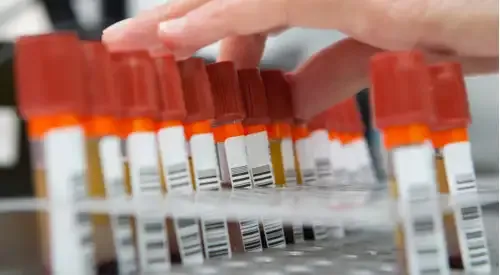Thrombosis and hemostasis
"Our objective is the early diagnosis, prevention and modern and individualized treatment of venous thromboembolic disease in any of its forms".
DR. RAMÓN LECUMBERRI
CODIRECTOR. HEMATOLOGY AND HEMOTHERAPY DEPARTMENT

What is thrombosis?
Alterations in thrombosis and hemostasis are caused by failures in the blood's mechanisms for maintaining a correct coagulability state.
If these mechanisms fail, problems may arise due to hypercoagulability, where the blood is thicker than normal and thromboses may appear anywhere in the body, or bleeding states with the consequent risk for the patient.
The Hematology and Hemotherapy Service of the Clinic has a team of highly qualified medical and nursing professionals, who have led numerous clinical trials in the field of new oral anticoagulants.
This team of professionals has made important scientific contributions in the field of thrombosis prophylaxis and treatment, the study of biomarkers, and in the development of experimental models in collaboration with the Cima Universidad de Navarra.

What are the symptoms of thrombosis?
VTE can occur without warning signs or symptoms and can go unnoticed.
In the case of deep vein thrombosis the characteristic clinical signs are
- Pain, which often begins in the calf, and is exacerbated by pressure at the muscle level.
- Swelling of the foot, ankle or leg.
- Redness and warmth of the limb.
In the case of pulmonary embolism the characteristic signs are:
- Breathing difficulty with dyspnea.
- Rapid breathing.
- Pain in the chest, which worsens when taking deep breaths.
- Bloody sputum (hemoptysis).
- Increased heart rate (tachycardia).
Do you have any of these symptoms?
You may have a clotting disorder
How is thrombosis diagnosed?

In the diagnosis of thrombosis, the presence of isolated symptoms and/or signs does not allow for certainty because they are non-specific. Therefore, complementary tests are always necessary.
In the Clinic we offer an integrated and fast diagnosis using modern imaging tests, including color duplex ultrasound, high resolution CT and PET.
In patients with suspected thrombophilic state, that is, hereditary predisposition to thrombosis, a complete analytical battery is performed, including genetic analysis, to rule out the main states of hypercoagulability.
Once diagnosed, one of the new oral anticoagulants will be offered, depending on individual characteristics: dabigatran, rivaroxavan, apixaban, edoxaban.
How is thrombosis treated?
Anticoagulants. Deep vein thrombosis is usually treated with medications known as "anticoagulants". These medications, which can be injected or taken in pill form, decrease the ability of the blood to form clots.
Injectable medications can be given in an injection under the skin (subcutaneously) or in an injection into the vein in the arm (intravenously). The initial use of low-molecular-weight heparins subcutaneously is generally recommended, followed by oral anticoagulants such as Sintrom.
In recent years the treatment of this disease has undergone a real revolution with the appearance of new oral anticoagulants (ACODs) that are replacing Sintrom: Dabigatran, Rivaroxaban, Epixaban, Apixaban, Edoxaban.
Thrombolytics. In severe cases of DVT or PD, the administration of clot-dissolving drugs, known as thrombolytics, may be indicated.
Until now, the current treatment of thrombosis, consisted of the administration of heparin intravenously or subcutaneously followed by Sintrom.
The new oral anticoagulants have made a strong breakthrough in the treatment and prevention of thrombosis and are replacing traditional drugs.
The new oral anticoagulants have several advantages for the patient:
- They do not require laboratory monitoring.
- They are convenient, since they are administered orally.
- They have few interactions with other drugs and foods.
- They lead to fewer hemorrhagic complications, especially cerebral hemorrhage.
Where do we treat it?
IN NAVARRA AND MADRID
The Hematology and Hemotherapy Service of the
at the Clínica Universidad de Navarra
The Hematology Service of the Clinic, formed by specialists of recognized national and international prestige, has integrated molecular diagnostic techniques and the use of new personalized treatments in its assistance work, allowing a more precise and fast diagnosis of the hematological diseases.
The joint work of the medical staff and the researcher facilitates the development and application of the new treatments and at the same time the precise evaluation of the result of the treatments.

Why at the Clinica?
- Experts in the development of Cellular Therapy treatments.
- International reference center in lymphomas, multiple myeloma and monoclonal gammopathies.
- Experts in the diagnosis and treatment of hemorrhagic and thrombotic problems.
Our team of professionals
Hematology specialists with experience in the treatment of thrombosis



















